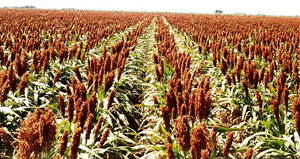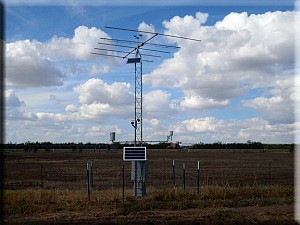SCS-2002-08
Billy E. Warrick (retired), Chris Sansone and Jason Johnson
Extension Agronomist, Extension Entomologist and Extension Economist
CONTENTS
- Introduction
- Seedbed Preparation
- Planting Information
- Fertilization
- Irrigation
- Weed Control
- Insects
- Diseases
- Desiccants
- Harvesting
- Marketing
- Acknowledgment
- Disclaimer
Introduction
Grain sorghum is grown on about 225,000 acres in West Central Texas. Soils suitable for the crop range from loamy sands to clay and most sorghum in the area is produced without irrigation. Annually, rainfall varies greatly and averages about 18 inches. This variability in rainfall accounts for most of the differences that occur in grain yields.
Management practices used by producers prior to planting until harvest are the focus of this publication. Linked to this publication are other sources of information that cover grain sorghum production outside the region; they include: “Irrigated and Dryland Grain Sorghum Production; South and Southwest Texas” (B-6048), “Managing Grain Sorghum for Maximum Profitability in the Texas High Plains” (SCS-2000-26) and “Grain Sorghum Production Handbook” from Kansas State University (C-687).
In general, producers select sorghum hybrids that have been shown to be adapted to local soils and growing conditions and provide consistently higher yields. Sorghum hybrids vary in many traits including: plant height, drought resistance, days-to-bloom, insect resistance, openness of head and color of grain.
Consult county Extension agents about hybrids variety tests conducted in county or regional Extension demonstrations and Texas AgriLife Research performance tests. Factors such as yield, standability, tolerance to important area diseases and maturity requirements weigh heavily in planting decisions. Generally, under favorable moisture and fertility conditions, medium or medium-late (bloom period) maturing hybrids have consistently produced the highest yields in West Central Texas.
Seedbed Preparation
Grain sorghum needs a warm, moist and firm seedbed that provides good seed-to-soil contact. An ideal seedbed would be weed free, have adequate moisture, be shaped and designed to minimize wind and water erosion, and have been prepared early enough to catch precipitation to fill the soil profile and allow the soil to firm before planting.
The biggest annual challenge to this region is building up a sufficient soil moisture reserve to a level suitable for profitable grain production. To accomplish this, producers should establish their seedbeds early. All tillage practices for the sorghum crop should be completed 4 to 5 months prior to seeding. Once the seedbeds are formed, consider establishing furrow dikes in order to capture precipitation and build up soil moisture.
Adequate surface residue is not provided by many of the crops produced within this region, so terracing, contouring, strip cropping, and windbreaks are generally used to prevent erosion. Of the crops grown in the area wheat produces the most residue, however, double cropping with sorghum is generally not successful, so a fallow period is needed.
Planting Information
Production practices such as planting rates and dates, selecting properly maturing hybrids, and row spacing are of utmost importance for profitable production. Select planting seed from a reliable seed dealer. To improve emergence, use seed treated with both an insecticide and fungicide.
Planting rates
Avoid excessive planting rates on both dryland and irrigated grain sorghum. Sorghum seed varies greatly in size and are small when compared to corn and soybeans. Shown in the photograph to the right are seed from two different hybrids. If these two hybrids were planted by weight of seed per acre, the smaller seed would provide a much thicker stand than the other. For example, Table 1. shows what would happen if both hybrids were planted at 4 pounds per acre and each had 75 percent field establishment. To obtain the desired plant population it is necessary to know more than how many pounds per acre to plant.
two different hybrids. If these two hybrids were planted by weight of seed per acre, the smaller seed would provide a much thicker stand than the other. For example, Table 1. shows what would happen if both hybrids were planted at 4 pounds per acre and each had 75 percent field establishment. To obtain the desired plant population it is necessary to know more than how many pounds per acre to plant.
| Table 1. Effect of seed size on planting rate and plant population when planting is based on pounds per acre. |
|||
| Example | Weight of 1,000 seeds (grams) |
Number of seed per acre planting 4 pounds |
Number of plants per acre with 75% emergence |
| Hybrid #1 | 19.0 | 95,500 | 71,600 |
| Hybrid #2 | 34.3 | 52,900 | 39,700 |
Under dryland conditions, planting rates on 40-inch rows should not exceed 2 to 3 seeds per foot (26,000 to 39,000 seed per acre). Dryland production using a “skip row” planting pattern should use about the same number of seed per row foot. When narrow rows are used under adequate irrigation, you would still have the same seed population per acre; however, the number of seed per foot of row should be adjusted accordingly. On 40-inch rows with limited irrigation, 5 to 6 seeds per foot are sufficient, and to produce maximum yields with full irrigation 8 seeds per row foot.
Planting dates
For highest yields, and to avoid possible sorghum midge damage, plant as soon as soil temperatures reach a minimum of 60 degrees F at planting depth (reading should be made between 7:00 and 8:00 a.m.). Optimum planting dates begin around April 15. Yield reductions can be expected from plantings made after June 15 due to sorghum midge damage, inadequate precipitation, heat stress and other climatic events.
Fertilization
Consider residual soil fertility and moisture before applying fertilizer. Balanced fertility (N, P, K) increases yield, improves water use efficiency, and insures an early harvest of a mature crop that is uniform in height.
Under non-irrigated conditions, sandy loam and other coarse-textured soils more frequently require fertilizer applications to improve the balance and level of plant nutrients than clay and clay loam soils. However, soils are not uniform and soil tests are the only way to determine the nutrients required for proper balance. When rainfall is low, existing soil moisture reserves influence the nutrient amounts required for an economical response. Refer to the fertility section of “Irrigated and Dryland Grain Sorghum Production; South and Southwest Texas” (B-6048) for additional information on nutrients needed by grain sorghum.
Nitrogen applications should be increased when grain sorghum follows grain sorghum or other high residue crops, particularly if seedbed preparation has been delayed and considerable residue has to be decomposed. If nitrogen is applied in bands at planting, avoid placing the seed in contact with the fertilizer. The nitrogen should be placed 2 to 4 inches to the side and 2 to 4 inches below the seed. Nitrogen may be chiseled into the side of the seedbed, as a second choice. Sidedressing part of the nitrogen after planting may be desirable in some areas. This allows time to evaluate the soil moisture reserve and estimate yield potential and fertility requirements. On sands, loams and other permeable soils, sidedressing also may minimize leaching losses from rainfall or irrigation.
Other Nutrients
Two other important nutrients for grain sorghum production in Texas are zinc and iron. Where soil phosphorus levels are “high” or “very high” and zinc levels are “low” to “medium”, the application of phosphorus fertilizer may induce a zinc deficiency. If soil test results indicate a possible zinc deficiency, zinc fertilizer should be broadcast and incorporated preplant or banded at planting. Foliar applications of zinc should be used as a preventative measure as damaged to the crop will occur before symptoms are recognized and corrected. For more information refer to “Zinc Deficiency and Fertilization” (L-721).
Iron deficiencies occur on some high pH (calcareous) soils in West Central Texas. Soil applied iron compounds have not been effective at economical rates. For more information refer to “Correcting Iron Deficiency in Grain Sorghum” (L-5155). An early foliar application of iron will reduce symptoms and encourage normal growth. In most acreage a second application usually is required in 7 to 10 days. In severe situations a third application may be needed to return plants to normal green color. Table 2 suggested foliar treatments to correct iron and/or zinc deficiencies.
| Table 2. Suggested sources, rates and timing of iron and zinc foliar sprays. | ||||
|---|---|---|---|---|
| Deficiency | Product* | Product/ 100 gals water |
Product/Acre | Timing |
| Iron | Iron sulfate (20% Fe) |
20 lbs (2.5% solution) |
1 lb 2 – 3 lbs |
10-14 days after emergence – 5 gals/A over crop row. Follow with 2 apps. @ 10-14 day interval @ 10-15 gals/A |
| Iron chelate (10% Fe) |
8 lbs (1%) |
0.4 – 0.5 lbs | 10-14 days after emergence – 5 gals/A over crop row. Follow with 2 apps. @ 10-14 day interval @ 10-15 gals/A | |
| Zinc | Zinc sulfate (30% Zn) |
2 lbs (1/2 %) |
0.2 – 0.4 lbs | 10-20 gals/A in first 30 days |
| Zinc chelate (9 to 10% Zn) |
2 qts (0.1%) |
1 pint | 10-20 gals/A in first 30 days | |
| Iron & Zinc | Iron sulfate + Zinc sulfate + urea fertilizer |
15 lbs+ 1 lb + 2 lbs |
3/4 Iron + 0.1-0.2 Zinc 1.5 lb Iron + 0.2-0.4 Zinc |
10-14 days after emergence – 5 gals/A over crop row. Follow with 2 apps. @ 10-14 day interval @ 10-15 gals/A |
| Iron sulfate + Zinc chelate |
15 lbs 3 pints |
3/4 Iron + 2.4 fl oz. 1.5 lb Iron + 5 fl oz. |
10-14 days after emergence – 5 gals/A over crop row. Follow with 2 apps. @ 10-14 day interval @ 10-15 gals/A | |
| Iron chelate + Zinc chelate |
6 lbs 3 pts |
follow mfg. directions |
10-14 days after emergence – 5 gals/A over crop row. Follow with 2 apps. @ 10-14 day interval @ 10-15 gals/A | |
| *Include a surfactant or other wetting agent. Product composition may vary. Select similar products or adjust mixing ratios to achieve comparable rates of nutrient application. | ||||
| Source: Updated information based on research results and recommendations through the Texas Agricultural Extension Service Soil, Water and Forage Testing Laboratory. | ||||
Irrigation
To produce optimum sorghum grain yields, 23 to 25 inches of water are required during the growing season. Adequate soil moisture is particularly important during the critical growth stages of boot, bloom and soft dough.
Sorghum grown on deep, well drained permeable soils usually develops extensive root systems. Mature plant roots may penetrate to depths of 4 to 6 feet in an ideal soil. Root development can be severely restricted by soil conditions such as excessively high or low soil moisture levels, hard pan and compaction.
Adequate soil moisture at planting helps assure uniform stands and contributes to early plant growth. Preplant irrigation can supply this moisture when winter and spring rainfall do not fill the root zone prior to planting. If the seedbed contains sufficient moisture for good germination and early plant growth but subsoil moisture is lacking, water may be supplied by irrigating after emergence. Whether irrigating before or after planting, apply no more water than required to fill the effective root zone.
High sorghum grain yields can be produced maintaining optimum soil moisture throughout the growing season. Irrigate when 50 to 60 percent of the available moisture has been used. Moderate plant moisture stress during early vegetative growth normally does not significantly limit grain yield. However, adequate moisture must be available by the boot stage. Greatest grain yield increases and water use efficiency have been obtained by irrigating so that ample soil moisture is available during the boot and bloom growth stages. Irrigation at the milk to soft dough stage also has consistently maintained high yield potential.
Irrigation intervals and the amount of water to apply is determined by:
- Rainfall
- soil’s water-holding characteristics
- plant rooting depth
- and climatic conditions
Realizing that sandy soils hold less water than heavier clay soils, apply smaller quantities more frequently to sandy soils. Shallow-rooted crops also require more frequent irrigation. Encourage deep rooting by maintaining only moderate soil moisture levels during early vegetative growth.
Average Daily Water Use by Grain Sorghum

The average daily water use by grain sorghum is usually less than 0.10 inch until approximately the seven-leaf stage, depending upon climatic conditions. At this stage, water use increases rapidly and is likely to average 0.30 inch per day during the boot, bloom and early grain development stages. Plan irrigations to provide adequate soil moisture during these high water requirement periods.
Weed Control
Weeds and grasses reduce yields and may interfere with harvesting. Satisfactory control can be obtained by combining timely cultivation, crop rotation and herbicide applications. Herbicides should be selected based on specific weed and grass problems encountered in each field and rotational crops to be planted following the sorghum harvest.
It is very difficult to control grass-type weeds with post-emergence herbicides so plan to use a preemergent herbicide if grass-type weeds are expected. Most of the preemergent herbicides used to control grass-type weeds require that the grain sorghum seed be coated with a seed safener which protects the young grain sorghum seedling from the harmful effects of the herbicide. Additional information on the herbicides available can be found in “Suggestions for Weed Control in Sorghum” (B-5045). Product labels should be consulted before applying any herbicide.
Insects
Insects and mites attack grain sorghum from planting until nearly harvest. The ability to identify damaging insect pests and beneficials, and to determine population levels, is a basic requirement for insect pest management. Inspect fields weekly when weather conditions are favorable for rapid pest population development. Information on these and other small grain pests and pesticides suggested for their control is presented in the attached PDF. “Managing Insect and Mite Pests of Sorghum ” (B-1220).
Diseases and Treatment
Treat grain sorghum with a seed protectant fungicide. Seed treatment helps prevent seedborne diseases, smuts, seed rots and seedling diseases. Reputable seed companies will clean seed before treating to eliminate weed seed and lightweight seed which often contain disease organisms. Identification of Grain Sorghum Diseases obtained from the Department of Plant Pathology and Microbiology at Texas A&M University should make a good reference for individuals interested in learning more about identifying diseases and determining methods of control.
Desiccants
In some situations, a desiccant to kill leaves on sorghum or grass and certain broad-leaf weeds may allow the grain to dry faster or reduce harvesting problems with vegetation. Sodium chlorate, with urea as a fire retardant, partially kills the plant and allows the head and leaves to dry rapidly for about 10 days after application. Rapid drying will occur only when there is high temperature and low humidity following application. Sodium chlorate may be applied at rates up to 6 pounds of active ingredient per acre when the sorghum is fully mature, or about 7 to 10 days before harvest. Use 5 to 10 gallons of solution per acre for aerial applications. Follow instructions given on the product label.
Harvesting
Harvest when grain moisture has reached the proper level for available handling facilities. Delay means losses. Acceptable long -term storage moisture is 13 percent. Grain with up to 18 percent moisture may be harvested if drying facilities are available.
To avoid waste have the combine operator follow the manufacturer’s manual on proper adjustment. Trash and cracked grain favor stored grain insects, moisture accumulation and mold damage. Practice good sanitation with all harvesting and storing. Protect grain from rodents and insects.
Marketing
Grain sorghum producers, individually or as a group, may (1) forward contract a growing crop through mutually agreed upon terms of trade, then deliver the grain at harvest, fulfilling the contract; (2) “hedge” the growing crop through a “cross-hedge” using corn on the futures market, then liquidate the hedge at harvest and deliver the grain to the local buyer for cash; (3) deliver and sell the crop at harvest to a local buyer for cash; (4) store the harvested crop in either on-farm or commercial storage facilities for cash sale at some later date; or (5) place the harvested crop under loan in an approved facility for later-than-harvest cash sale, or redeem the loan and deliver title to the grain to the government.
Weigh each marketing method carefully. Location in relation to feedlots, poultry and egg producing units, swine or sheep feeding, in addition to export demand, will help determine the most advantageous method during any marketing year.
Acknowledgment
Appreciation is expressed to all the individuals that produced the various factsheets and publications that are linked to in these pages.
Disclaimer
Educational programs conducted by the Texas AgriLife Extension Service are open to all people without regard to race, color, sex, disability, religion, age or national origin.
Suggested pesticides must be registered and labeled for use by the Environmental Protection Agency and the Texas Department of Agriculture. Pesticide label clearances are subject to change.
The pesticide user is responsible for a pesticide’s used on his own crop, as well as problems caused by drift or pesticide movement from his property to other properties.
The information given herein is for educational purposes only. “Mention or display of a trademark, proprietary product, or firm in text or figures on this page or subsequently linked pages does not constitute an endorsement by any Extension page author and does not imply approval to the exclusion of other suitable products or firms.”
Issued in furtherance of AgriLife Extension Work in Agriculture and Home Economics, Acts of Congress of May 8, 1914, as amended, and June 30, 1914, in cooperation with the United States Department of Agriculture. Edward Smith, Director, Texas AgriLife Extension Service, The Texas A&M University System.
01-2002 Revision
AGR 2





